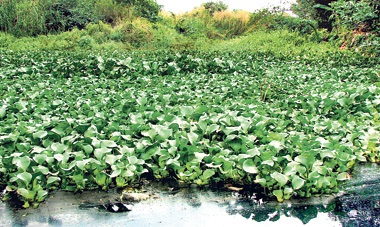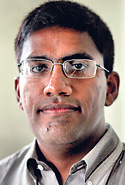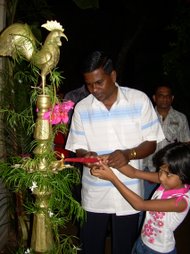Drowning in dirt | |||
Is the scenic Kolonnawa wetland heading for an ecological disaster? | |||
| Kumudini Hettiarachchi reports For The Sunday Times .LK | |||
The Parliament, the seat of Sri Lanka’s legislature in Sri Jayewardenepura-Kotte, nestles against lush greenery and is ensconced on the beautiful shimmering waters of the Diyawanna Oya. This is the country’s icon in a spectacular setting. But is this just a mirage? Is Parliament surrounded by the Diyawanna Oya which is hydrologically linked to the Kolonnawa wetland, sitting on a biological time-bomb, slowly and surely ticking its way to an ecological disaster?
Invasive species of noxious vegetation, algae and fish are taking over the Kolonnawa marsh, covering about 214 ha, and to cap it all the water quality has dropped, with faecal coliform being found in abundance. This is what has been uncovered by researchers from three organizations who have fanned out across the Kolonnawa marsh, not only on foot but also by boat, and collected data, water samples and carried out interviews of 175 households in the “fringe area” and 50 households in the “basin” between August 2007 and June 2008. The filling of marshy land beyond Kolonnawa is happening mostly by private owners and the Sri Lanka Lowland Reclamation and Development Corporation (SLLRDC) has to a great extent been able to protect state land. Now rather than land-filling the major problem is pollution and not industrial pollution but from households, says researcher and Environmental Engineer, Missaka Hettiarachchi, from the Moratuwa University. The research indicates that pollution-indicative invasive weeds such as pond apple (Annona glabra) and Japan Jabara or water hyacinth (Ipomia crassipes) have ousted characteristic freshwater marsh vegetation including rushes, sedges and grasses, The Sunday Times understands. The researchers have just written an eye-opening draft report on ‘The situation analysis of water services in the Kolonnawa marsh’. The research has been carried out with a grant from the International Foundation of Science, Sweden and technical support from the Central Environmental Authority (CEA), the SLLRDC, the Urban Development Authority (UDA) and the Irrigation Department. The Women for Water Partnership, Netherlands, has co-funded part of the field work. The eco-hydrology of the marsh was studied by the Department of Chemical and Process Engineering, Moratuwa University, with the principal researcher being Mr. Hettiarachchi and the senior supervisor Prof. Ajith de Alwis. The ecological, gender and sociological aspects were covered by Dr. Deepthi Wickramasinghe of the Department of Zoology, University of Colombo; Kusum Athukorale of the NetWwater – Sri Lanka; and freelance researcher Ravi Peiris respectively. Mr. Hettiarachchi explained that tropical freshwater fish such as murrel and stinging catfish in the deep-water areas of the marsh have more or less become extinct, with pollution-resistant exotic invasive fish like thilapia, kissing gourami and knife fish taking their place. The comparative study is being done with data collected under a 1994 Wetland Site Report produced by the CEA. With regard to the proliferation of faecal E-coli, Mr. Hettiarachchi says that the World Health Organization standard for any water area which has human activity or even where people engage in recreational activity is a maximum count of 1000 units per 100 ml. “Water quality observations taken from four points in the marsh indicate an average of 2,800 at certain points and a shocking maximum of 50,000 units per 100 ml,” he says, stressing however that the marsh water is not used for human consumption as most people have pipe-borne water. The wetland is also not used for bathing, swimming or pleasure boating although some youth engage in fishing and excursions.
Explaining that only 75% of the research has been completed, Mr. Hettiarachchi says there are indications that pollution of the Kolonnawa marsh may be reducing the capacity of this wetland to act as a “flood detention” area while also being a health hazard to people. This wetland marsh “detains” or collects flood waters from the metropolitan and suburban areas and drains them, preventing the flooding of Colombo city. Pointing a finger at the invasive weeds, this environmental engineer says that although the impact has not been calculated yet, they critically damage the hydraulics of the wetlands, as these terrestrials with their large root system capture silt which in turn could cause the filling up of the wetland. They also block the canals and small waterways. Nutrient enrichment, especially nitrogen, phosphate and potassium, of the marsh caused by the pollution has led to the rapid growth of algae, making the water green. The algae which produces oxygen during the day through photosynthesis (making of food) consumes oxygen in the night. This could restrict the oxygen available for the usual vegetation and fish in the marsh area, killing them off, he says. On the health aspect, The Sunday Times learns that 35% of the households surveyed had health problems such as typhoid, chikungunya, dengue and leptospirosis (rat fever). Further study, however would be needed to firmly establish a link. There is a National Wetland Policy and a National Wetlands Steering Committee. The institutional infrastructure and legislation are in place. What is needed is to get together and work out a solution to the pollution, adds Mr. Hettiarachchi, so that the rapid degradation of the marsh is halted immediately. How does pollution occur? The pollution is mainly by residential waste-water, sewage and also solid waste, the research has found.
Getting into the intricacies, Mr. Hettiarachchi explains that as the fringe area of the wetland has a high water table, the soakage pits for faecal matter built in homes tend to either directly overflow into the marsh or indirectly due to seepage, making the area nutrient-rich. “The septic tank and soakage pit system does not work under flood conditions,” he says adding that it usually works only if there is a good layer of soil to act as a strainer, leaving the contaminants behind and sending only the water sans the bacteria to the soil. The answer, of course, would be to revamp the sanitation system by introducing anaerobic filters or “eco-san” (ecological sanitation) dry toilets, The Sunday Times learns. In the first process, the effluents would pass through a filter system where anaerobic bacteria would breakdown the contaminants while in dry toilets the solid faecal matter is not flushed with water but sent into a dry pit along with ash. The dry faecal matter gets composted with time and could be used in horticulture, he says. |
"Star Lanka Online" Our NEW Web site And Web TV Channel Launched
TFGE , The Future Global Educational Center Has Launched
the official web site, called
*** Star Lanka Online Dot Com ........................
www.starlankaonline.com will be completed in very near future....
*** Star Lanka Online TV Channel,..................
Just One Click ahead ...
Now you can watch "Star Lanka Online TV" channel broadcasts from Matara, Sri Lanka in most part of the day. Still we are keeping a test transmission also. There is a link right side of your hand to watch our TV channel. You can watch (Click On the Box) live channel on this site without going to another site to watch the TV. and also recorded parts, following the below link.
the official web site, called
*** Star Lanka Online Dot Com ........................
www.starlankaonline.com will be completed in very near future....
*** Star Lanka Online TV Channel,..................
Just One Click ahead ...
Now you can watch "Star Lanka Online TV" channel broadcasts from Matara, Sri Lanka in most part of the day. Still we are keeping a test transmission also. There is a link right side of your hand to watch our TV channel. You can watch (Click On the Box) live channel on this site without going to another site to watch the TV. and also recorded parts, following the below link.
Place your Own Ad Here
Tuesday, September 16, 2008
Is the scenic Kolonnawa wetland heading for an ecological disaster?
Subscribe to:
Post Comments (Atom)























































No comments:
Post a Comment